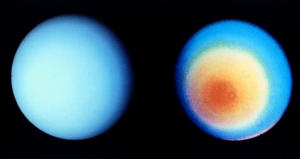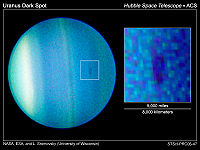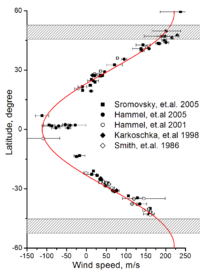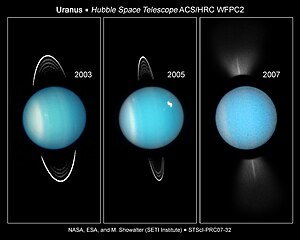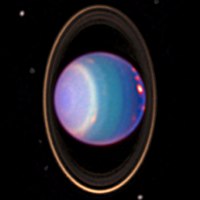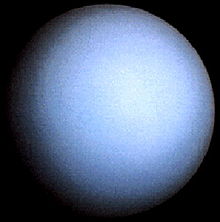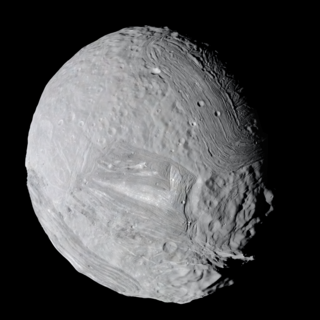
Miranda, also designated Uranus V, is the smallest and innermost of Uranus's five round satellites. It was discovered by Gerard Kuiper on 16 February 1948 at McDonald Observatory in Texas, and named after Miranda from William Shakespeare's play The Tempest. Like the other large moons of Uranus, Miranda orbits close to its planet's equatorial plane. Because Uranus orbits the Sun on its side, Miranda's orbit is nearly perpendicular to the ecliptic and shares Uranus's extreme seasonal cycle.

Umbriel is the third-largest moon of Uranus. It was discovered on October 24, 1851, by William Lassell. It was discovered at the same time as Ariel and named after a character in Alexander Pope's 1712 poem The Rape of the Lock. Umbriel consists mainly of ice with a substantial fraction of rock, and may be differentiated into a rocky core and an icy mantle. The surface is the darkest among Uranian moons, and appears to have been shaped primarily by impacts. However, the presence of canyons suggests early endogenic processes, and the moon may have undergone an early endogenically driven resurfacing event that obliterated its older surface.

Uranus is the seventh planet from the Sun. It is a gaseous cyan-coloured ice giant. Most of the planet is made of water, ammonia, and methane in a supercritical phase of matter, which in astronomy is called 'ice' or volatiles. The planet's atmosphere has a complex layered cloud structure and has the lowest minimum temperature of 49 K out of all the Solar System's planets. It has a marked axial tilt of 82.23° with a retrograde rotation period of 17 hours and 14 minutes. This means that in an 84-Earth-year orbital period around the Sun, its poles get around 42 years of continuous sunlight, followed by 42 years of continuous darkness.
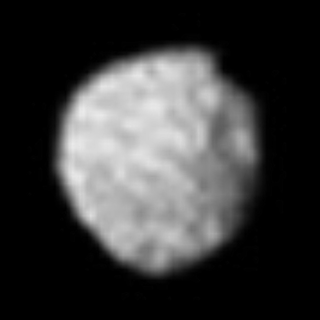
Puck is an inner moon of Uranus. It was discovered in December 1985 by the Voyager 2 spacecraft. The name Puck follows the convention of naming Uranus's moons after characters from Shakespeare. The orbit of Puck lies between the rings of Uranus and the first of Uranus's large moons, Miranda. Puck is approximately spherical in shape and has diameter of about 162 km. It has a dark, heavily cratered surface, which shows spectral signs of water ice.

Oberon, also designated Uranus IV, is the outermost and second-largest major moon of the planet Uranus. It is the second-most massive of the Uranian moons, and the tenth-most massive moon in the Solar System. Discovered by William Herschel in 1787, Oberon is named after the mythical king of the fairies who appears as a character in Shakespeare's A Midsummer Night's Dream. Its orbit lies partially outside Uranus's magnetosphere.

Titania, also designated Uranus III, is the largest of the moons of Uranus. At a diameter of 1,578 kilometres (981 mi) it is the eighth largest moon in the Solar System, with a surface area comparable to that of Australia. Discovered by William Herschel in 1787, it is named after the queen of the fairies in Shakespeare's A Midsummer Night's Dream. Its orbit lies inside Uranus's magnetosphere.

Ariel is the fourth-largest moon of Uranus. Ariel orbits and rotates in the equatorial plane of Uranus, which is almost perpendicular to the orbit of Uranus and so has an extreme seasonal cycle.

The Great Dark Spot was one of a series of dark spots on Neptune similar in appearance to Jupiter's Great Red Spot. In 1989, GDS-89 was the first Great Dark Spot on Neptune to be observed by NASA's Voyager 2 space probe. Like Jupiter's spot, Great Dark Spots are anticyclonic storms. However, their interiors are relatively cloud-free, and unlike Jupiter's spot, which has lasted for hundreds of years, their lifetimes appear to be shorter, forming and dissipating once every few years or so. Based on observations taken with Voyager 2 and since then with the Hubble Space Telescope, Neptune appears to spend somewhat more than half its time with a Great Dark Spot. Little is known about the origins, movement, and disappearance of the dark spots observed on the planet since 1989.

Uranus, the seventh planet of the Solar System, has 28 confirmed moons. Most of them are named after characters that appear in, or are mentioned in, the works of William Shakespeare and Alexander Pope. Uranus's moons are divided into three groups: thirteen inner moons, five major moons, and ten irregular moons. The inner and major moons all have prograde orbits and are cumulatively classified as regular moons. In contrast, the orbits of the irregular moons are distant, highly inclined, and mostly retrograde.

The rings of Uranus are intermediate in complexity between the more extensive set around Saturn and the simpler systems around Jupiter and Neptune. The rings of Uranus were discovered on March 10, 1977, by James L. Elliot, Edward W. Dunham, and Jessica Mink. William Herschel had also reported observing rings in 1789; modern astronomers are divided on whether he could have seen them, as they are very dark and faint.
An extraterrestrial vortex is a vortex that occurs on planets and natural satellites other than Earth that have sufficient atmospheres. Most observed extraterrestrial vortices have been seen in large cyclones, or anticyclones. However, occasional dust storms have been known to produce vortices on Mars and Titan. Various spacecraft missions have recorded evidence of past and present extraterrestrial vortices. The largest extraterrestrial vortices are found on the gas giants, Jupiter and Saturn, and the ice giants, Uranus and Neptune.

The exploration of Uranus has, to date, been through telescopes and a lone probe by NASA's Voyager 2 spacecraft, which made its closest approach to Uranus on January 24, 1986. Voyager 2 discovered 10 moons, studied the planet's cold atmosphere, and examined its ring system, discovering two new rings. It also imaged Uranus' five large moons, revealing that their surfaces are covered with impact craters and canyons.

The atmosphere of Uranus is composed primarily of hydrogen and helium. At depth it is significantly enriched in volatiles such as water, ammonia and methane. The opposite is true for the upper atmosphere, which contains very few gases heavier than hydrogen and helium due to its low temperature. Uranus's atmosphere is the coldest of all the planets, with its temperature reaching as low as 49 K.

The atmosphere of Triton is the layer of gases surrounding Triton. Like the atmospheres of Titan and Pluto, Triton's atmosphere is composed primarily of nitrogen, with a smaller component of methane. It hosts a layer of organic haze extending up to 30 kilometers above its surface and a deck of thin bright clouds at about 4 kilometers in altitude. Due to Triton's low gravity, its atmosphere is loosely bound, extending over 800 kilometers from its surface.

The climate of Titan, the largest moon of Saturn, is similar in many respects to that of Earth, despite having a far lower surface temperature. Its thick atmosphere, methane rain, and possible cryovolcanism create an analogue, though with different materials, to the climatic changes undergone by Earth during its far shorter year.
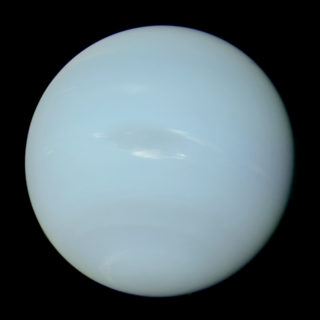
Neptune is the eighth and farthest known planet from the Sun. It is the fourth-largest planet in the Solar System by diameter, the third-most-massive planet, and the densest giant planet. It is 17 times the mass of Earth, and slightly more massive than fellow ice giant Uranus. Neptune is denser and physically smaller than Uranus because its greater mass causes more gravitational compression of its atmosphere. Being composed primarily of gases and liquids, it has no well-defined solid surface. The planet orbits the Sun once every 164.8 years at an orbital distance of 30.1 astronomical units. It is named after the Roman god of the sea and has the astronomical symbol , representing Neptune's trident.
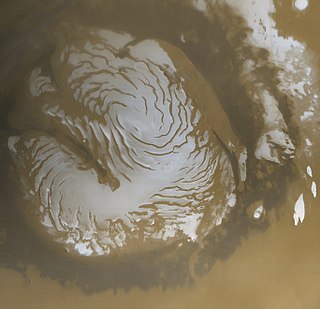
The planet Mars has two permanent polar ice caps. During a pole's winter, it lies in continuous darkness, chilling the surface and causing the deposition of 25–30% of the atmosphere into slabs of CO2 ice (dry ice). When the poles are again exposed to sunlight, the frozen CO2 sublimes. These seasonal actions transport large amounts of dust and water vapor, giving rise to Earth-like frost and large cirrus clouds.

The atmosphere of Jupiter is the largest planetary atmosphere in the Solar System. It is mostly made of molecular hydrogen and helium in roughly solar proportions; other chemical compounds are present only in small amounts and include methane, ammonia, hydrogen sulfide, and water. Although water is thought to reside deep in the atmosphere, its directly measured concentration is very low. The nitrogen, sulfur, and noble gas abundances in Jupiter's atmosphere exceed solar values by a factor of about three.

The climate of Pluto concerns the atmospheric dynamics, weather, and long-term trends on the dwarf planet Pluto. Five climate zones are assigned on the dwarf planet: tropics, arctic, tropical arctic, diurnal, and polar. These climate zones are delineated based on astronomically defined boundaries or sub-solar latitudes, which are not associated with the atmospheric circulations on the dwarf planet. Charon, the largest moon of Pluto, is tidally locked with it, and thus has the same climate zone structure as Pluto itself.

The climate of Triton encompasses the atmospheric dynamics, weather, and long-term atmospheric trends of Neptune's moon Triton. Although the atmosphere of Triton is rather thin, with a surface pressure of only 1.4 Pa at the time of Voyager 2's flyby but heavily variable, it still drives active, global weather and climate cycles and heavily influences Triton's glacial activity.
